Bottom of the Premier League table, things are looking particularly bleak for Swansea City. Mere months ago, the club was touted as a role model, with its unique mix of fan involvement and a distinct footballing style. Once a haven for the development of up and coming managers, with both Merseyside clubs coached by Liberty Stadium graduates in the 2013/14 season, the club has become something of a rotating door in that sense. Worse yet, the purchasing of a major stake by new American owners was done behind the back of the Supporters Trust that formed the back-bone of the club by owning 21% of it, causing frosty tension and even the possibility of a lawsuit about the nature of the sale.
How might decision makers at the club attempt to halt this descent down a slippery slope that we have seen so many other clubs topple down before?
Reinstate the Swansea Way
The defining feature of Swansea City has been, until recently, its style of football. The club enamoured hipsters all over the world, myself included, with its unique blend of possession based football from Roberto Martinez to Brendan Rodgers to Michael Laudrup. One of the most unfortunate developments of the last few years has been the loss of this identity, beginning with the appointment of club stalwart Garry Monk as manager.
Monk led the club to a record high 8th placed finish with a slightly more pragmatic style than fans were used to. At the time, no one was complaining, but the following season’s early problems quickly complicated matters. To those of us involved in assessing underlying performance, Swansea’s regression came as no surprise. Before long, Monk was gone and replaced. His replacement, Francesco Guidolin, met the same fate and was succeeded this season by Bob Bradley. Barely a year later after Monk was sacked by the club, Bradley was also on his way out.

Having a distinct tactic is useful for a variety of reasons. It forces recruitment through an extra layer of checks, moving the question from ‘Is this player good?’ to ‘Is he good for us?’. The same check applies to managers, and, in truth, it is here that decision makers at the club have abandoned the club's distinct style.
In Swansea’s case, a possession style was most useful as a defensive tool. Where big clubs with high average possession often spend most of it in their opponent’s half, Swansea would recycle the ball in their own half as a defensive tactic. This made breaking them down hard, while also making their attacks slow.

This season, Swansea’s defence has been anything but hard to break down, and their attack has been anything but slow. Considering many of the personnel in the team are the same as under Michael Laudrup, this seems a bizarre state of affairs. This is clearest in the futility of the performances of Leon Britton, whose conscientious and careful possessions of the ball are completely undermined by the team’s overall system and focus on optimistic wing play. 
On the other hand, having a similar squad spine to the possession days should make it easier to reinstate the style. The most difficult part, and the most controversial of my suggestions, would be in resisting the urge to hire a manager with a different system for the sake of it.
Resist Panic Hiring
Alan Curtis is an extremely experienced member of staff, and one that has been at the club throughout its entire journey. His training methods will be familiar to the players, as will his ideas, as has been evident from his caretaker stints: last campaign when Guidolin was unfortunately ill, Curtis stepped in and coached the team for a couple of games. Against West Bromwich Albion, the team played closer to the Swansea Way than they had in years, and strolled nonchalantly to a 1-0 win.
Appointing him as a caretaker manager until the end of the season isn’t even a new idea – the club did it after Monk was sacked, only to back-track and appoint Guidolin shortly after. Curtis should be given the reigns until the end of the season not because there is a chance that he may be long-term manager material like Monk, but because the mid-season options for replacements are so dire.

Considering the financial might of the Premier League, these are rather uninspiring possibilities - lest we forget that Rafa Benitez is manager of Newcastle in the division below. Clement and Rowett are managers with the potential to be future candidates, but, ideally, you’d like to see them with at least another Championship club first. Premier League experience is not a necessity, but some suitable level of experience is, and it's hard to say either of them have it yet. Marcelino is another one I would be interested in, but has already been interviewed for the position before and concerns about his grasp of the language reportedly put the club off.
As much as it may initially seem risky, waiting until the summer allows the club to appoint a manager with the advantage of certainty about what competition they will be in, a much larger pool of targets, and enough time for suitable due diligence.
It seems odd to say this about a club with a recent history of managerial casualties, but the biggest obstacle for Swansea City’s survival isn’t who is manager, it is who is playing.
Recruit with focus
For a club lauded for its intelligent recruitment, particularly the time-old legend of £2m Michu, the squad has deteriorated to an almost laughable state. Wayne Routledge is starting in the Premier League in 2016. Ashley Williams, long-time captain, was replaced by Ajax bench-player Mike van der Hoorn and Barnsley's Alfie Mawson. Andre Ayew, who scored an impressive 12 Premier League goals last campaign, was replaced by Nathan Dyer returning from a loan to Leicester City.
The one area that the club did solve a problem was up-front, with the signings of Fernando Llorente and Borja Baston, the latter of which has struggled to get game time but will likely still come good. Unfortunately, the Spanish pair are forced to rely on their chances being created predominantly by the ineffectual Modou Barrow, who is a player with clear potential but with equally clear deficiencies, and Routledge, who is useless in a wing-oriented counter-attacking system at the age of 31. Jefferson Montero, by far the club’s best chance-creator, has failed to cement a place in the starting eleven so far, but will hopefully soon.
More than anything, the combination of a deterioration in squad quality and incoherent tactical style has damaged Gylfi Sigurdsson, unquestionably the club’s star player. Since Wilfried Bony was sold to Manchester City, the Icelandic talisman has been forced to carry the increasingly heavy burden of the team’s attacks on his shoulders. This can be seen most clearly in the ratio of his shots to key passes over the last few seasons, and in the number of shots from outside of the box.

The club desperately need another winger and a centre-back. They will already be working on this, and have brought in famed analytics-community pioneer Daniel Altman as a ‘transfer consultant’. However, if reports are to be believed, it could be argued that Altman’s expertise will be used at the wrong end of the recruitment process - WalesOnline reported that Altman will not suggest players to the club, but rank their separately created shortlists. Given the depth of statistical data available and the relative ease with which tactical styles can be profiled, it would surely make more sense for shortlists to be generated through statistical filters before further holistic analysis is done with more traditional methods.
Regardless of the process, the focus of January's recruitment should be honed on the specific qualities needed from new players. Ideally, the initial check would be whether or not they are suited to a possession-based tactical system, but this would depend on that style being revived. Recent reports have linked Swansea to Luciano Narsingh, PSV's speedster winger, but I would argue that the team needs more of a Dusan Tadic style wide player - one that can join in comfortably with build-up, like Andre Ayew did last season and Wayne Routledge used to be able to. Centre-backs are particularly difficult to recruit, so before doing so the club should figure out who it is that he is likely to be playing with: Jordi Amat or Federico Fernandez? Each have different individual weaknesses that should be complemented by their new partner.
Conclusion The task of saving Swansea City is a huge but not impossible one. It takes investment from the new owners, conscientious decision making, and the ability to hold nerve when panic alarms are ringing all around. To maximise the club's chances of survival and also build a stable foundation for rebounding back from relegation, three recommendations should be adopted: reinstate the Swansea Way, resist panic hiring, and recruit with focus.
Appendix: Post Clement Update
Since this piece was posted, Paul Clement has been appointed as the manager of Swansea. Of all the candidates available, he is the one I would have complained about least. There are some obvious caveats, like his limited experience as a first team manager, but to what extent you can criticise him for that is difficult to say given that his sacking at Derby was confusing (to say the least). Stylistically, Clement's Derby were reminiscent of the Swansea of yesteryear, attacking slowly and indirectly: 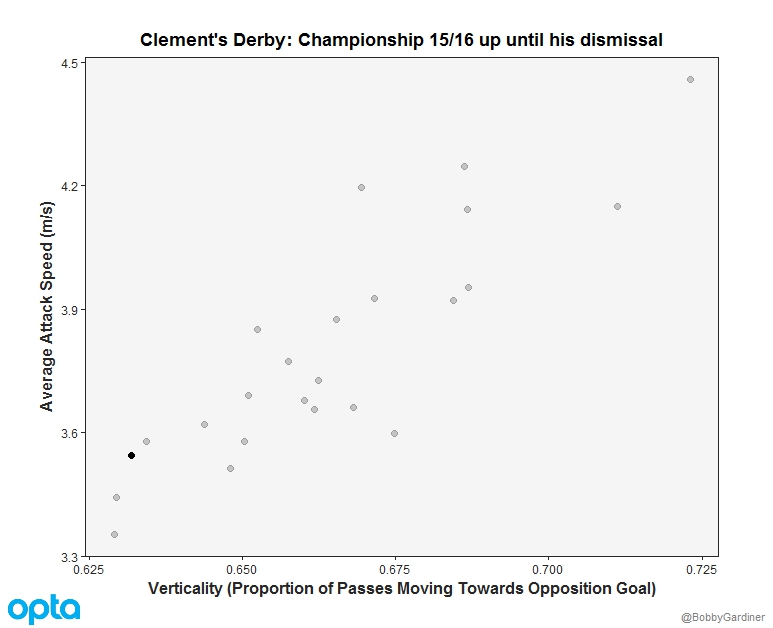
This is a promising finding for those who, like myself, are keen for the Swansea Way to return. Although I may have waited until the summer myself, the Clement appointment can hardly be accused of being made in a panic and, hopefully, signals a return to the style of football that the club became known for. Let's see how the January transfer window plays out - over to you, Altman.
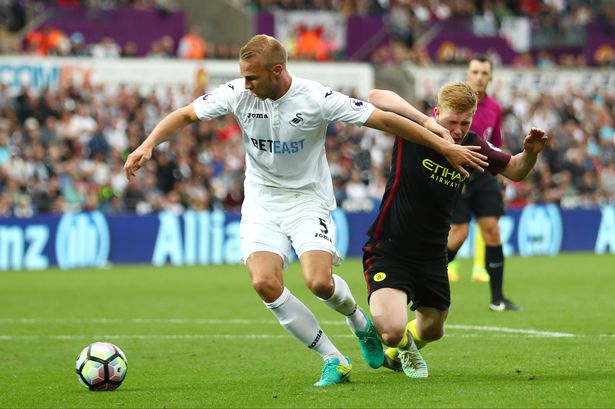
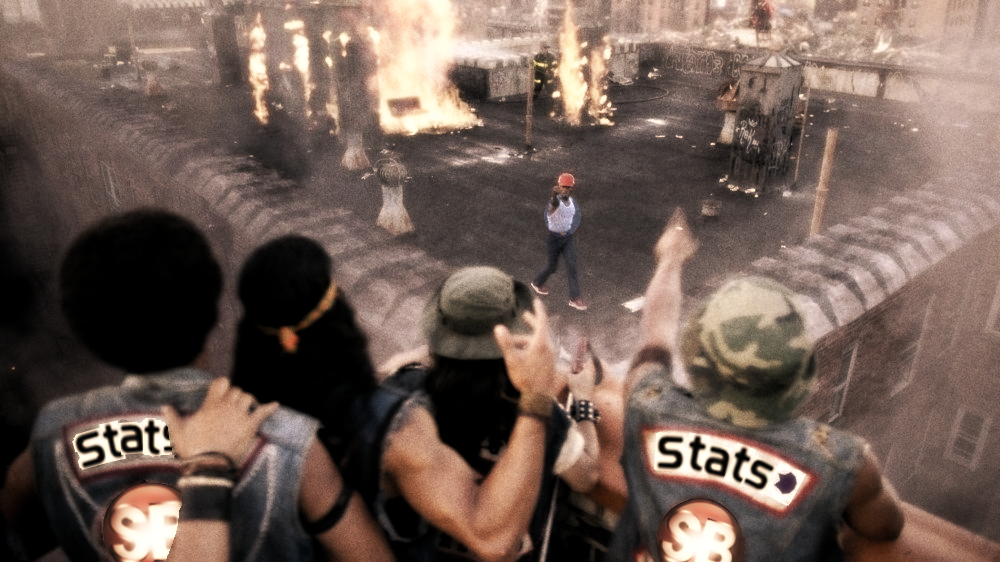
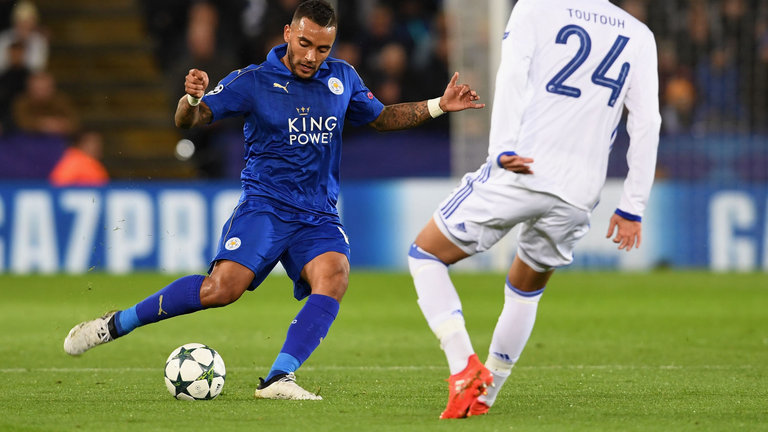
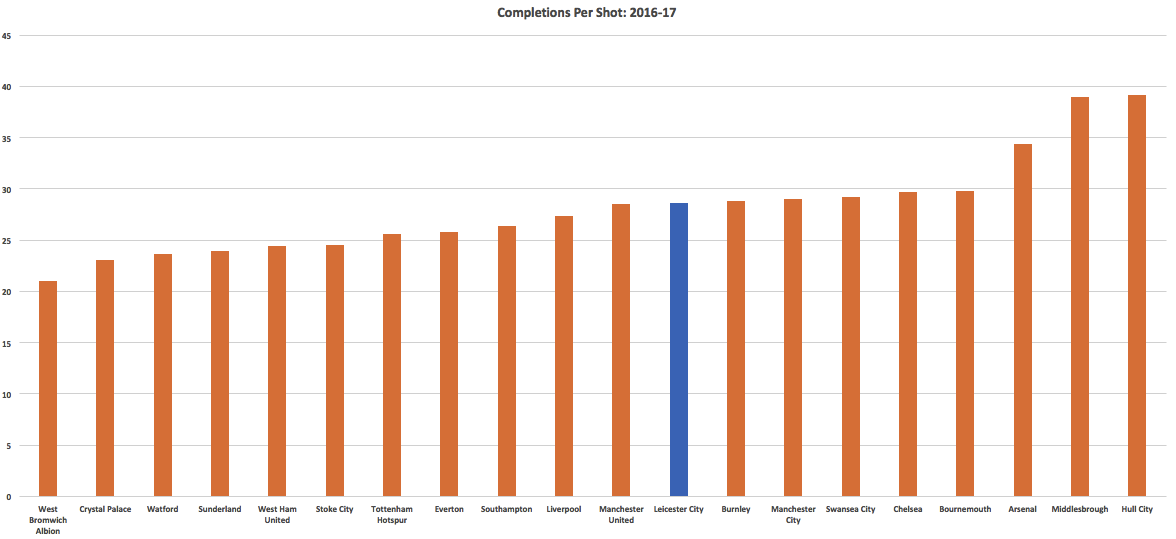 Last year they were lightning fast at transitioning from having the ball to getting a shot, which provided strong shot volumes.
Last year they were lightning fast at transitioning from having the ball to getting a shot, which provided strong shot volumes. 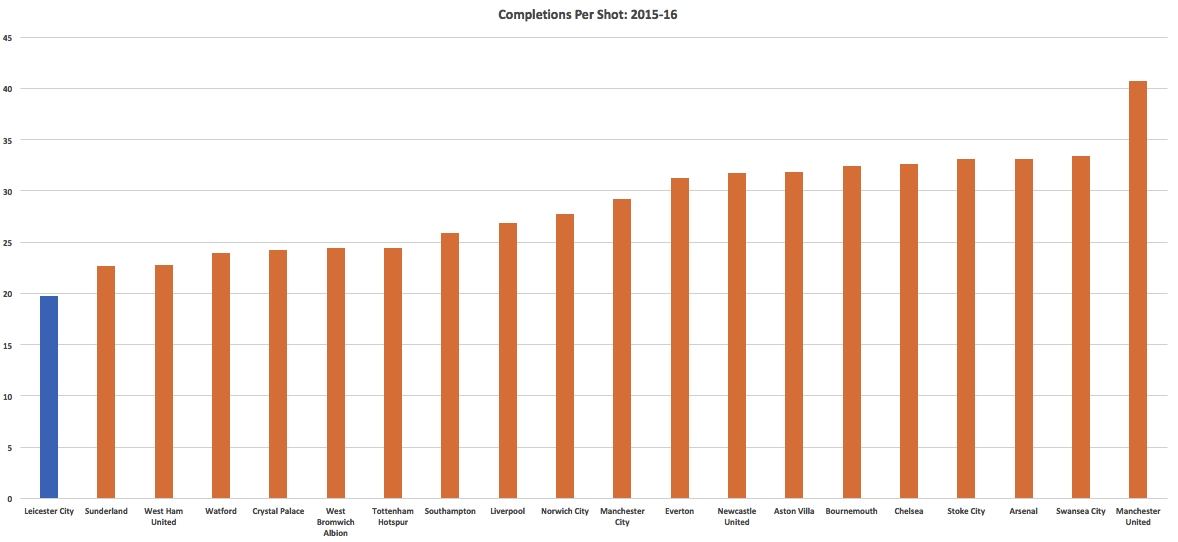 This is because they don't get the ball into the final third nearly as often as last year. Last year they were tied for the highest % of passes ending in the final third, this year they are middle of the pack. So we have a few questions to answer:
This is because they don't get the ball into the final third nearly as often as last year. Last year they were tied for the highest % of passes ending in the final third, this year they are middle of the pack. So we have a few questions to answer: 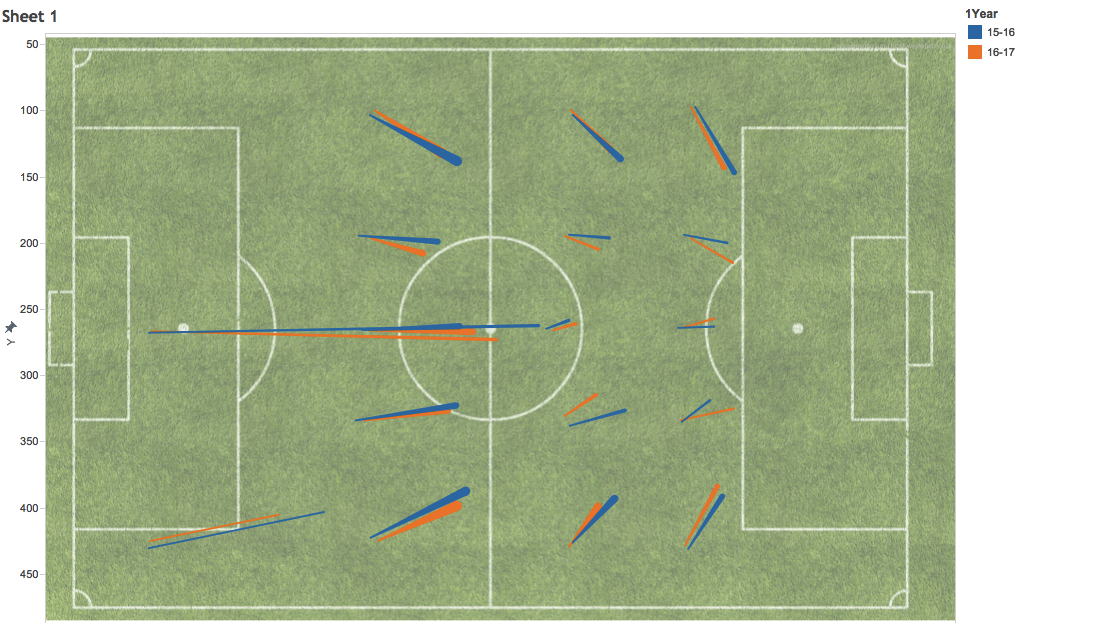 We can clearly see a pretty large shift from last year to this in their own half and especially the "edge" area as I like to call it, right over the halfway line. This is backed up in pitch-wide passing length stats, again no one has changed more. Leicester are playing much shorter passes this season.
We can clearly see a pretty large shift from last year to this in their own half and especially the "edge" area as I like to call it, right over the halfway line. This is backed up in pitch-wide passing length stats, again no one has changed more. Leicester are playing much shorter passes this season.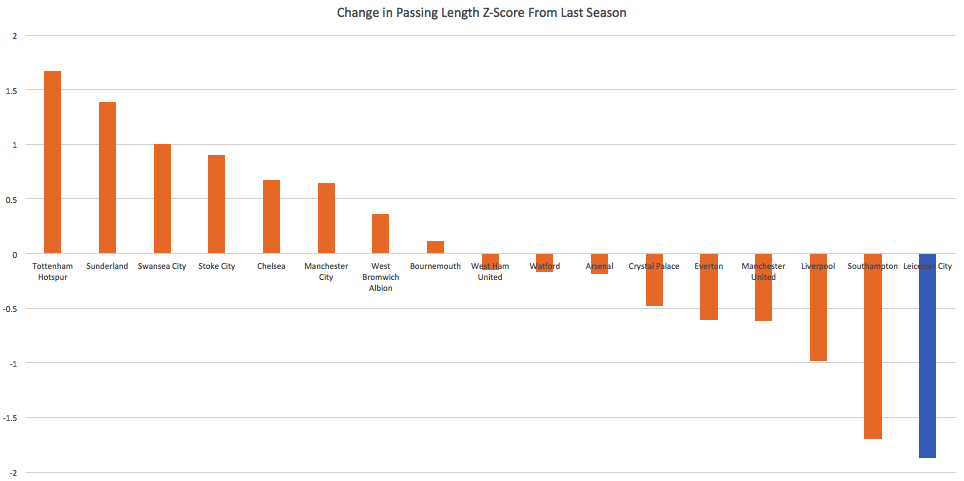 So let's look at how these changes are affecting the team, starting up front. Mahrez Last year Mahrez passes in the attacking zones led to key passes quickly about 50% more often than they do this year. The stat about him not completing a pass to Vardy for nearly 2 months went viral and it does point out a stark shift. Here is the sum total of those completions (leading into the Man City game).
So let's look at how these changes are affecting the team, starting up front. Mahrez Last year Mahrez passes in the attacking zones led to key passes quickly about 50% more often than they do this year. The stat about him not completing a pass to Vardy for nearly 2 months went viral and it does point out a stark shift. Here is the sum total of those completions (leading into the Man City game). 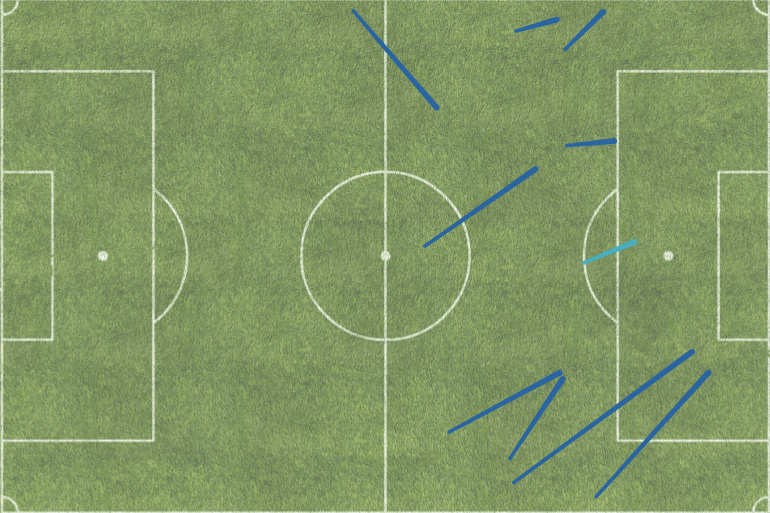 compared to last year:
compared to last year: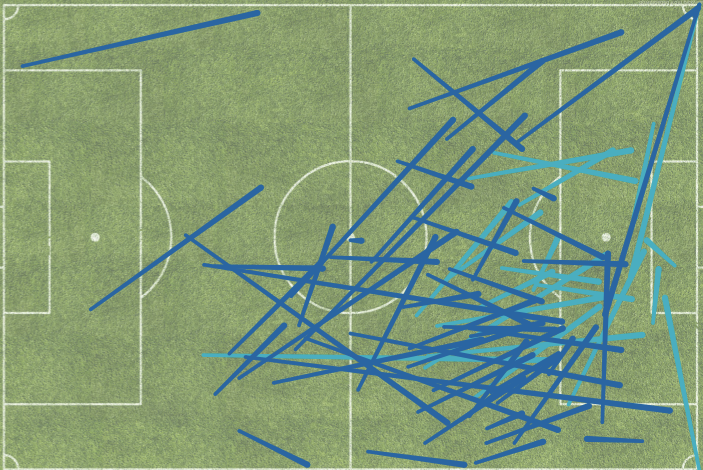 Plenty of those passes toward Vardy were played from more inside and central positions not way out on the wing. This is the area that has seen the largest change in passing types for Mahrez:
Plenty of those passes toward Vardy were played from more inside and central positions not way out on the wing. This is the area that has seen the largest change in passing types for Mahrez: 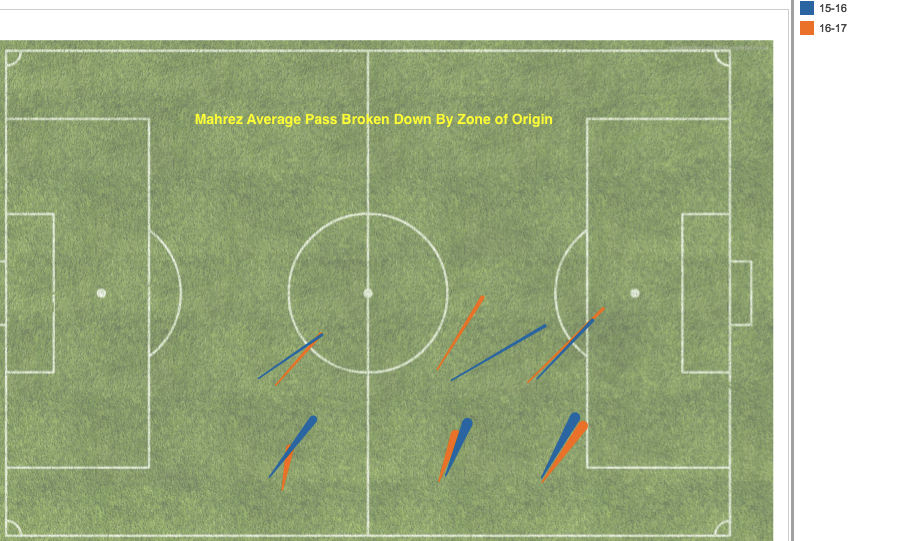 While a right-winger turning insular is not an isolated example across the globe this year in politics and sport, Mahrez's turn has not resulted in success like many of the others. What are the reasons for this? While you may instantly jump to Vladimir Putin as the man behind this, I say look past the obvious answer and suspect more packed defenses. More porous defenses=more forward passes to Vardy, right? Vardy Last year 6.3% of Mahrez's passes were forward completions to Vardy, this season that is a measly 1.7%. This is a large contributor to Vardy's collapsing shot rate but not the complete story. Vardy's shot rate has halved this season, while his deep reception rate (passes completed to him within 30 yards of goal) has dropped by 25%. That's a large drop but obviously not enough to explain the full shot drop. Helping to explain more of that is his rate of passes starting within 30 yards of goal has actually increased 11% despite getting less service there. This suggests shooting is a less appealing option from similar positions than it was last year and sure enough the block rate on his shots has surged as well. Last year his shots were blocked 19% of the time (4th lowest among top 50 shooters), this year they are blocked 27% of the time (20th most among top 50 shooters, of which he's barely inside after being 3rd last season). So Vardy's Mahrez pipeline has been completely shut off without much protest and while the new pipelines are still under review and yet to be built he is getting fewer dangerous touches, passing more instead of shooting when he does get deep, and getting blocked more when he does shoot. All of this points directly to more defenders in his way. So is this a final ball problem where opponents have more men back or are Leicester's legendary lightning counters just not getting started? Let's look at how Mahrez is getting fed.
While a right-winger turning insular is not an isolated example across the globe this year in politics and sport, Mahrez's turn has not resulted in success like many of the others. What are the reasons for this? While you may instantly jump to Vladimir Putin as the man behind this, I say look past the obvious answer and suspect more packed defenses. More porous defenses=more forward passes to Vardy, right? Vardy Last year 6.3% of Mahrez's passes were forward completions to Vardy, this season that is a measly 1.7%. This is a large contributor to Vardy's collapsing shot rate but not the complete story. Vardy's shot rate has halved this season, while his deep reception rate (passes completed to him within 30 yards of goal) has dropped by 25%. That's a large drop but obviously not enough to explain the full shot drop. Helping to explain more of that is his rate of passes starting within 30 yards of goal has actually increased 11% despite getting less service there. This suggests shooting is a less appealing option from similar positions than it was last year and sure enough the block rate on his shots has surged as well. Last year his shots were blocked 19% of the time (4th lowest among top 50 shooters), this year they are blocked 27% of the time (20th most among top 50 shooters, of which he's barely inside after being 3rd last season). So Vardy's Mahrez pipeline has been completely shut off without much protest and while the new pipelines are still under review and yet to be built he is getting fewer dangerous touches, passing more instead of shooting when he does get deep, and getting blocked more when he does shoot. All of this points directly to more defenders in his way. So is this a final ball problem where opponents have more men back or are Leicester's legendary lightning counters just not getting started? Let's look at how Mahrez is getting fed. 
 He is coming into his own half to get the ball significantly more and when he is getting the ball in attacking areas, it's coming from backwards passes a ton more this year. This implies a set D and established possession instead of Mahrez in space with pace. Another problem is last year Leicester had two midfielders who could push the ball forwards, now they have just one. Honing in on those forward (0-10 yard closer to goal) passes into attacking zones we find that Drinkwater, Kante, and Simpson all completed 30+ of these type passes to Mahrez last year. This year Drinkwater and Simpson are on similar pace but no one else has completed more than 4. He had 3 sources of the ball in attack last season and this year he has just 2. When you aren't getting much from your left winger, you are playing two strikers, and your fullbacks rarely get forward, any limitation on Mahrez will ripple out throughout the entire team. So we know a lot more about what the problem is up front now. Vardy isn't getting the ball deep enough because Mahrez can't find him, he's being forced to pass instead of shoot and his shots are being blocked more, Mahrez is having to come back to get the ball more, isn't getting it while it's progressing towards goal, and only has 2 sources of passes in danger zones. The loss of Kante is part of the problem. Is the rest just opponents adjusting? Surely it's not that simple right? Let's look one more level back to see if we can spy any more differences in their own-half buildup. If opponents really were not caught out this year and were allowing them calm buildup, we might see significantly different passing patterns. Do we? Yes.
He is coming into his own half to get the ball significantly more and when he is getting the ball in attacking areas, it's coming from backwards passes a ton more this year. This implies a set D and established possession instead of Mahrez in space with pace. Another problem is last year Leicester had two midfielders who could push the ball forwards, now they have just one. Honing in on those forward (0-10 yard closer to goal) passes into attacking zones we find that Drinkwater, Kante, and Simpson all completed 30+ of these type passes to Mahrez last year. This year Drinkwater and Simpson are on similar pace but no one else has completed more than 4. He had 3 sources of the ball in attack last season and this year he has just 2. When you aren't getting much from your left winger, you are playing two strikers, and your fullbacks rarely get forward, any limitation on Mahrez will ripple out throughout the entire team. So we know a lot more about what the problem is up front now. Vardy isn't getting the ball deep enough because Mahrez can't find him, he's being forced to pass instead of shoot and his shots are being blocked more, Mahrez is having to come back to get the ball more, isn't getting it while it's progressing towards goal, and only has 2 sources of passes in danger zones. The loss of Kante is part of the problem. Is the rest just opponents adjusting? Surely it's not that simple right? Let's look one more level back to see if we can spy any more differences in their own-half buildup. If opponents really were not caught out this year and were allowing them calm buildup, we might see significantly different passing patterns. Do we? Yes. 
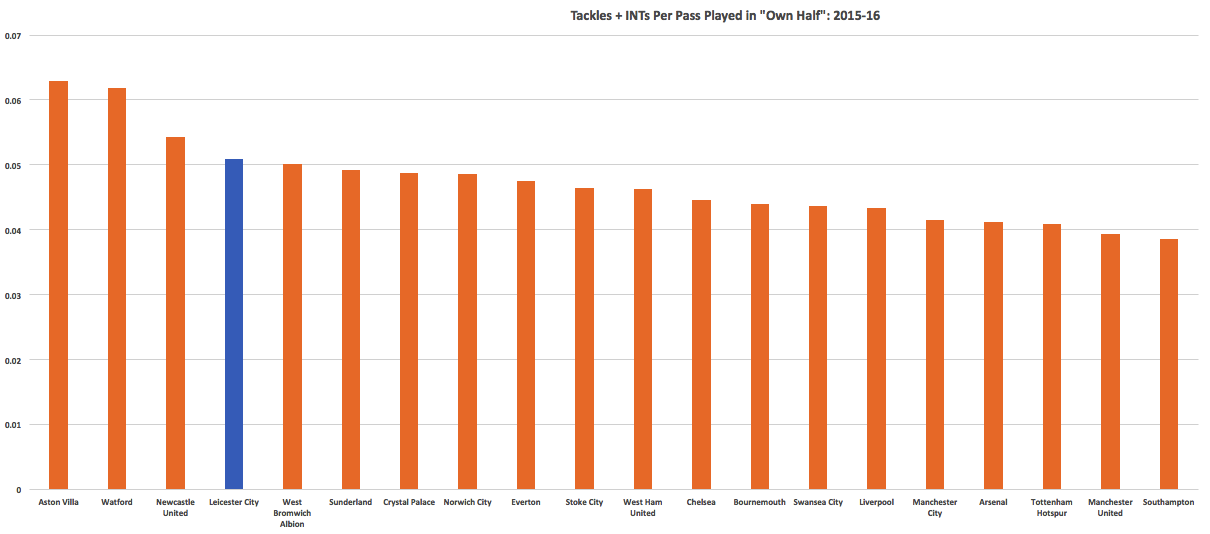
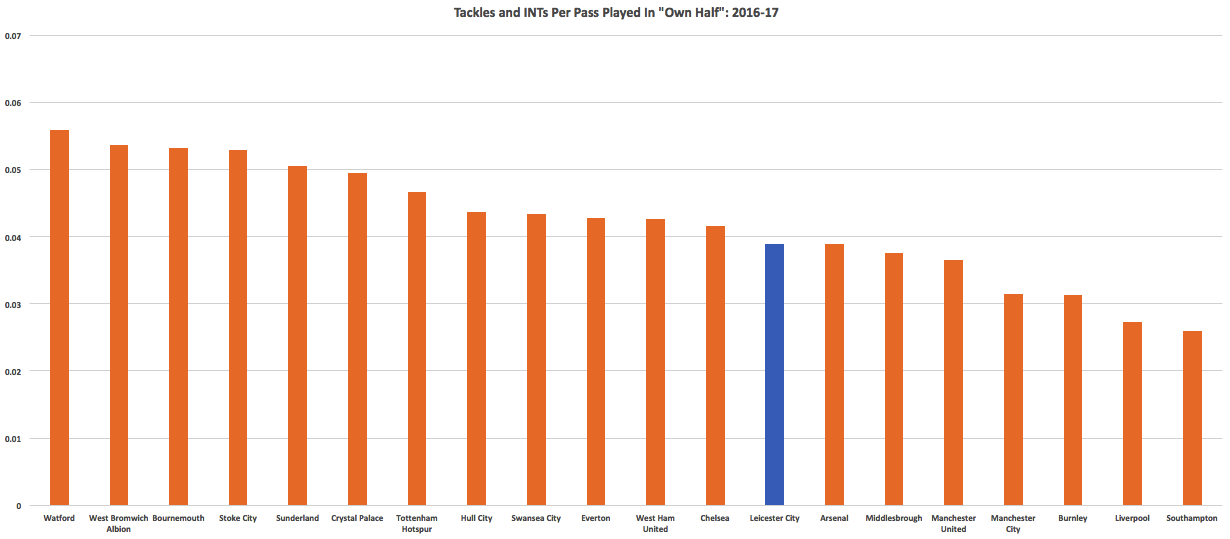 And we do see it here. Teams are attempting to win the ball a lot less this year in Leicester's half than they were last season and limiting Leicester's long forward balls. Leicester, lacking a strong companion for Drinkwater, have passed backwards a lot more and haven't really figured out a Plan B. They aren't able to easily get the ball forward or play a possession game and that's what they need to be able to do now. Their completion %'s are actually higher in their own half and just past midfield this season but fall in the money areas in front of goal. It really might have been as simple as "Don't press Leicester". The league might have finally figured it out and N'Golo Kante isn't walking through that door. So What Can Leicester Do To Jumpstart the Attack?
And we do see it here. Teams are attempting to win the ball a lot less this year in Leicester's half than they were last season and limiting Leicester's long forward balls. Leicester, lacking a strong companion for Drinkwater, have passed backwards a lot more and haven't really figured out a Plan B. They aren't able to easily get the ball forward or play a possession game and that's what they need to be able to do now. Their completion %'s are actually higher in their own half and just past midfield this season but fall in the money areas in front of goal. It really might have been as simple as "Don't press Leicester". The league might have finally figured it out and N'Golo Kante isn't walking through that door. So What Can Leicester Do To Jumpstart the Attack?  The free-flowing attack of last year is probably not coming back. Teams simply won't allow it to that extent. So what are some steps Leicester can take to play better in a different way?
The free-flowing attack of last year is probably not coming back. Teams simply won't allow it to that extent. So what are some steps Leicester can take to play better in a different way? 
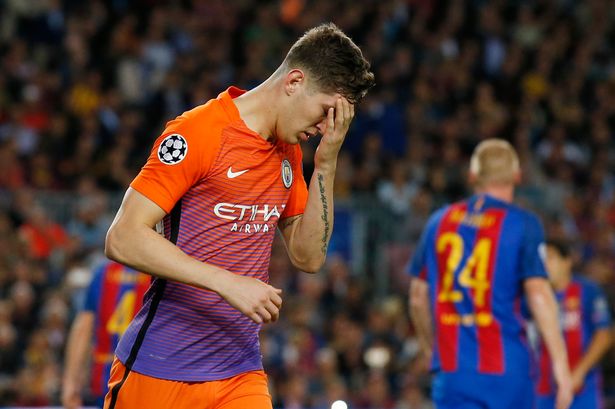
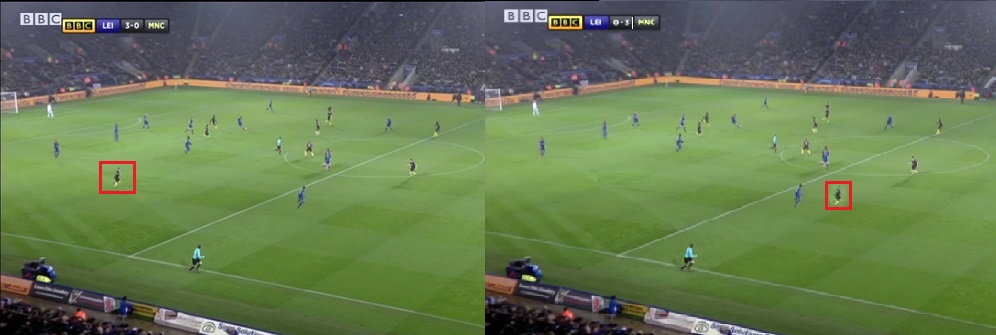 Beyond that, City now host Watford (fine, okay) and Arsenal (probably the last team they could do with facing right now) but with the knowledge that these vulnerabilities are there. Guardiola is unlikely to send his team out without a view to minimising these problems. While Chelsea could be written off as an unfortunate by-product of pushing for a win, Leicester showed that the team needed to focus from the kick off. Will Guardiola change? It’s doubtful, but he’ll rarely field a back three of John Stones and two full backs again, and Nicolas Otamendi will surely return quickly. The bigger picture is that they conceded nine big chances in thirteen games before these two fixtures, which is excellent and some natural reversion against what we've seen this last ten days is more likely than not in forthcoming games. They haven’t become a bad team. During the last nine games since their six game win streak came to an end they’ve gone 3-3-3 but during that time they’ve outshot their opposition 155 to 75, and the only time they were outshot in a single game all season was against Tottenham. That was the only game they didn’t exceed 60% of the possession--four times exceeding 70%--and they disrupt the opposition’s passing more than any other team in the league. Chelsea's attack and a reawoken Vardy and Riyad Mahrez will not be in the opposition every week.
Beyond that, City now host Watford (fine, okay) and Arsenal (probably the last team they could do with facing right now) but with the knowledge that these vulnerabilities are there. Guardiola is unlikely to send his team out without a view to minimising these problems. While Chelsea could be written off as an unfortunate by-product of pushing for a win, Leicester showed that the team needed to focus from the kick off. Will Guardiola change? It’s doubtful, but he’ll rarely field a back three of John Stones and two full backs again, and Nicolas Otamendi will surely return quickly. The bigger picture is that they conceded nine big chances in thirteen games before these two fixtures, which is excellent and some natural reversion against what we've seen this last ten days is more likely than not in forthcoming games. They haven’t become a bad team. During the last nine games since their six game win streak came to an end they’ve gone 3-3-3 but during that time they’ve outshot their opposition 155 to 75, and the only time they were outshot in a single game all season was against Tottenham. That was the only game they didn’t exceed 60% of the possession--four times exceeding 70%--and they disrupt the opposition’s passing more than any other team in the league. Chelsea's attack and a reawoken Vardy and Riyad Mahrez will not be in the opposition every week. 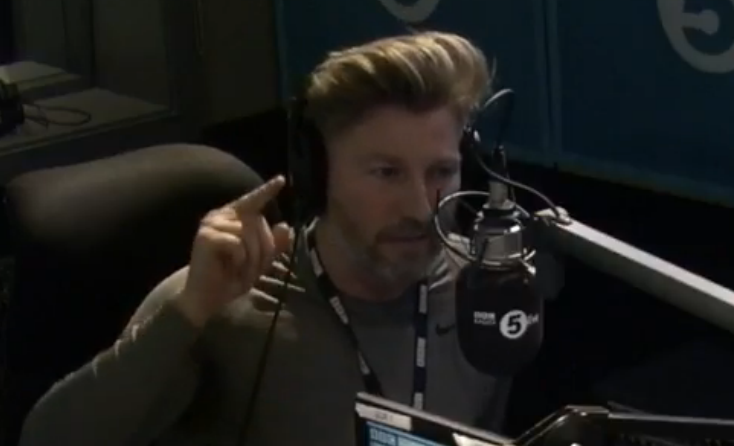 It’s 15 league games and the experiment has hit a bump in the road. Centre backs are hard to find these days yet once more seem required with Eliaquim Mangala discarded and Vincent Kompany perma-crocked, as do full backs, regardless of the system Guardiola ends up favouring, and it will be interesting if City enter the transfer market this January. There will be a hell of a lot of analysis this week and beyond searching to solve the problems and arguing what should be done. Just this evening Robbie "Foghorn" Savage advanced heated views on Radio FiveLive and most won't recognise that this is likely to be a quickly forgotten low point and a wider perspective is more supportive of the whole project. If there is concern, it's that City have seen excellent baseline numbers fail to translate into title winning form since their 2013-14 win, and with Chelsea winning and hot and Arsenal not too far behind, there isn't much time for Guardiola to lose if the title is to remain a realistic goal. He needs to find a way to allow his team to exert decisive control, especially in bigger games, but they aren't too far away from where they need to be. Now imagine if Kevin De Bruyne had just finished that chance against Chelsea...
It’s 15 league games and the experiment has hit a bump in the road. Centre backs are hard to find these days yet once more seem required with Eliaquim Mangala discarded and Vincent Kompany perma-crocked, as do full backs, regardless of the system Guardiola ends up favouring, and it will be interesting if City enter the transfer market this January. There will be a hell of a lot of analysis this week and beyond searching to solve the problems and arguing what should be done. Just this evening Robbie "Foghorn" Savage advanced heated views on Radio FiveLive and most won't recognise that this is likely to be a quickly forgotten low point and a wider perspective is more supportive of the whole project. If there is concern, it's that City have seen excellent baseline numbers fail to translate into title winning form since their 2013-14 win, and with Chelsea winning and hot and Arsenal not too far behind, there isn't much time for Guardiola to lose if the title is to remain a realistic goal. He needs to find a way to allow his team to exert decisive control, especially in bigger games, but they aren't too far away from where they need to be. Now imagine if Kevin De Bruyne had just finished that chance against Chelsea...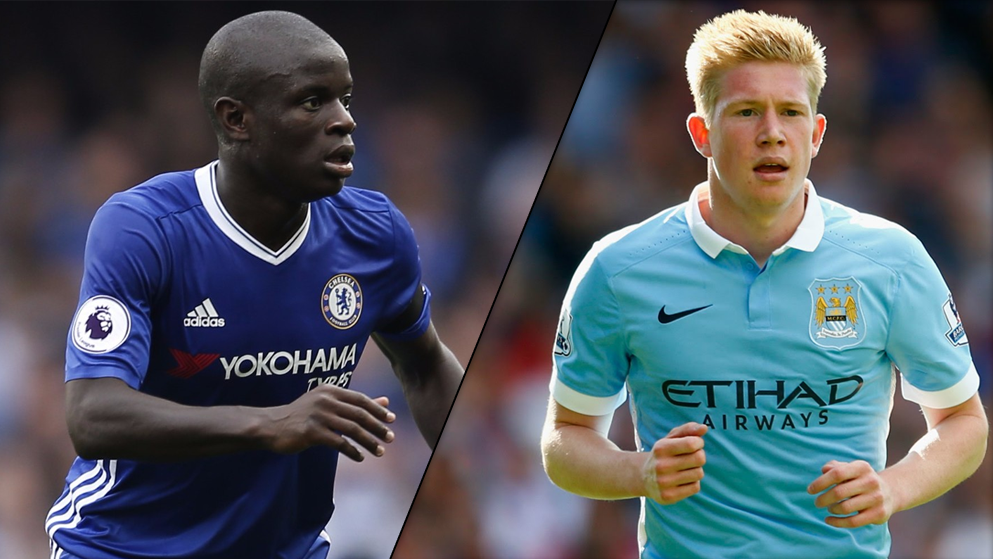
 Some people noted that these rankings tend to be very attacker/attacking midfielder dominated. Aren’t there any defenders good at progressing the ball? Well of course there are, but due to their position on the field it’s harder for them to pass into dangerous locations. This becomes very clear when you see where these dangerous locations are on the pitch:
Some people noted that these rankings tend to be very attacker/attacking midfielder dominated. Aren’t there any defenders good at progressing the ball? Well of course there are, but due to their position on the field it’s harder for them to pass into dangerous locations. This becomes very clear when you see where these dangerous locations are on the pitch:  In the above picture, the whiter, the more dangerous. For a defender, no matter how good at passing he is, it’s going to be very difficult to pass into these dangerous locations and thus gain xG added. On the other hand, an attacker is always close to this ‘danger zone’, and thus has more opportunities to gain xG added. As
In the above picture, the whiter, the more dangerous. For a defender, no matter how good at passing he is, it’s going to be very difficult to pass into these dangerous locations and thus gain xG added. On the other hand, an attacker is always close to this ‘danger zone’, and thus has more opportunities to gain xG added. As  As expected, locations closer to the opponents goal are usually locations where actions yield a higher xG added. However, there are a few more interesting things to see here: Right in front of goal, the average xG added for an action is pretty low. If a player has the ball at such a location, it will be very hard to improve the location any further. Not a lot of actions take place in this location, and if they do they will have a low xG added. The areas around all have high xG added. These locations are significantly less dangerous than the spot right in front of goal, but are very close to it and thus make it easy to pass to more dangerous positions. The most interesting thing however to me, is that it looks like the ‘half spaces’ are the best places to pass from. Half-spaces are certain areas of the field, often used in tactical analysis.
As expected, locations closer to the opponents goal are usually locations where actions yield a higher xG added. However, there are a few more interesting things to see here: Right in front of goal, the average xG added for an action is pretty low. If a player has the ball at such a location, it will be very hard to improve the location any further. Not a lot of actions take place in this location, and if they do they will have a low xG added. The areas around all have high xG added. These locations are significantly less dangerous than the spot right in front of goal, but are very close to it and thus make it easy to pass to more dangerous positions. The most interesting thing however to me, is that it looks like the ‘half spaces’ are the best places to pass from. Half-spaces are certain areas of the field, often used in tactical analysis.  They are usually described as good locations, due to the fact that they give a player a lot of passing directions, and due to the fact that they are usually less crowded than the center. If you want to read more about half-spaces, read
They are usually described as good locations, due to the fact that they give a player a lot of passing directions, and due to the fact that they are usually less crowded than the center. If you want to read more about half-spaces, read  The black line represents the line where the expected xG added is equal to the actual xG added. That means that players far above the line are performing better than expected, whereas players below the line are performing worse than expected. NOTE: This metric only measures ball progression skill. Therefore players who tend to be more concentrated on goal scoring don’t necessarily show up in a positive way. This doesn’t mean they’re not good, just that they don’t excel in this metric. Whether this over/underperformance is due to skill or luck remains to be seen. It’s very much possible that the a large part of the skill measured with xG added is getting into good positions repeatedly, just like with normal xG. It must also be noted that the sample size is relatively small, as all players played a maximum of 10 games. It’s definitely interesting though that players in deeper position like Kanté and Stones pop-up using this method, even though their positions make it harder for them to perform well in xG added. It might be a method to look for good passers in more defensive roles. For instance, Claudio Bravo tops the goalkeepers by a mile, which feels right. That’s all for now. Thanks for reading. If you have any feedback/questions feel free to contact me on Twitter at
The black line represents the line where the expected xG added is equal to the actual xG added. That means that players far above the line are performing better than expected, whereas players below the line are performing worse than expected. NOTE: This metric only measures ball progression skill. Therefore players who tend to be more concentrated on goal scoring don’t necessarily show up in a positive way. This doesn’t mean they’re not good, just that they don’t excel in this metric. Whether this over/underperformance is due to skill or luck remains to be seen. It’s very much possible that the a large part of the skill measured with xG added is getting into good positions repeatedly, just like with normal xG. It must also be noted that the sample size is relatively small, as all players played a maximum of 10 games. It’s definitely interesting though that players in deeper position like Kanté and Stones pop-up using this method, even though their positions make it harder for them to perform well in xG added. It might be a method to look for good passers in more defensive roles. For instance, Claudio Bravo tops the goalkeepers by a mile, which feels right. That’s all for now. Thanks for reading. If you have any feedback/questions feel free to contact me on Twitter at 
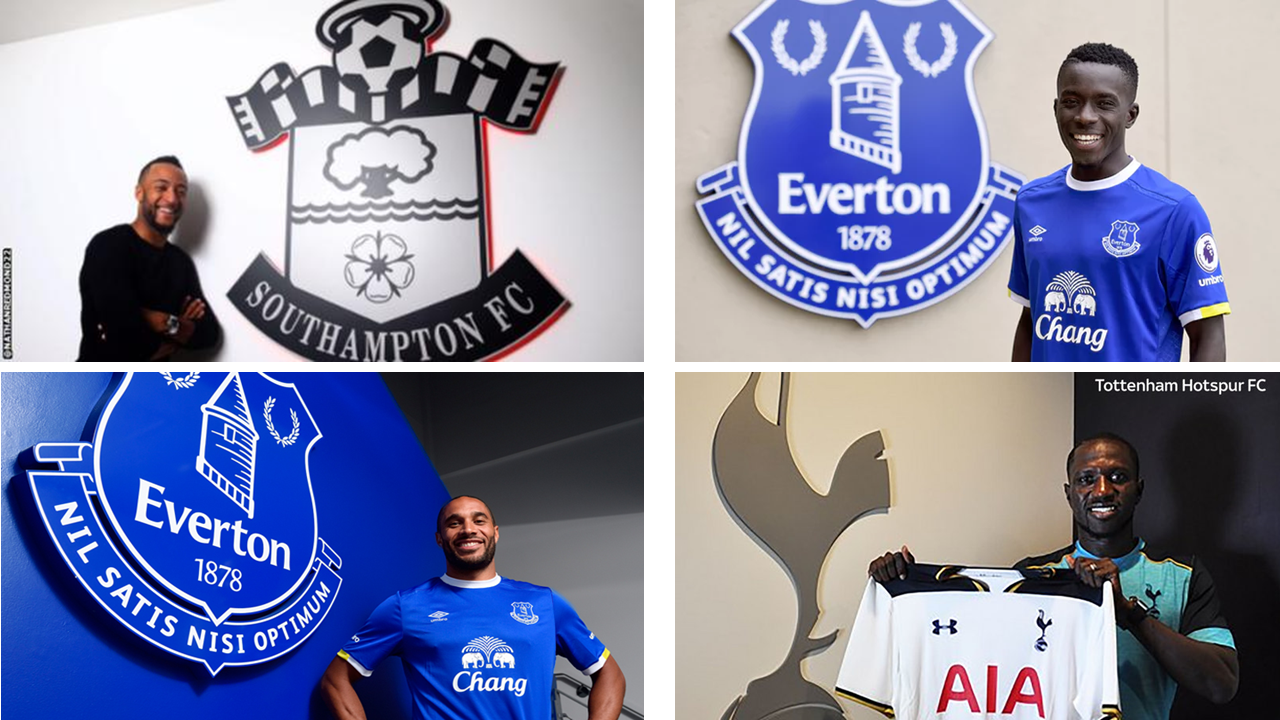
 First of all, I strongly think that Ulloa being there is a bit of an oddity: most of his appearances were late substitutions when Leicester were holding onto a 1-0 lead and therefore his stats are representative of this unique predicament. Ozil is the most distinctive player in the league. Looking through his closest players Nacho Monreal and Bacary Sagna can raise a few eyebrows but all in all even they are considerably far away from his style and therefore don’t reveal much about him. It’s a bit like the US mainland and Australia being amongst the closest countries to Hawaii; so treat that with due suspicion. The rest of the players seem to make good footballing sense. I’ll leave it to the readers to read through the results and make their own judgements. Another interesting question which I thought of was this: which players represent the best recruitment opportunities in the sense that they have similar styles to players who play for much better ranked teams. Something like Sunderland players having similar styles to players from Arsenal, Manchester City or Tottenham. There are several ways to answer this question. Let’s start by the simplest: for each player I computed the average final league position of the 10 closest players, and subtracted that number from his own team’s final position. The players for whom this number was highest can be considered to represent the “best” opportunities. The following table shows the top 10:
First of all, I strongly think that Ulloa being there is a bit of an oddity: most of his appearances were late substitutions when Leicester were holding onto a 1-0 lead and therefore his stats are representative of this unique predicament. Ozil is the most distinctive player in the league. Looking through his closest players Nacho Monreal and Bacary Sagna can raise a few eyebrows but all in all even they are considerably far away from his style and therefore don’t reveal much about him. It’s a bit like the US mainland and Australia being amongst the closest countries to Hawaii; so treat that with due suspicion. The rest of the players seem to make good footballing sense. I’ll leave it to the readers to read through the results and make their own judgements. Another interesting question which I thought of was this: which players represent the best recruitment opportunities in the sense that they have similar styles to players who play for much better ranked teams. Something like Sunderland players having similar styles to players from Arsenal, Manchester City or Tottenham. There are several ways to answer this question. Let’s start by the simplest: for each player I computed the average final league position of the 10 closest players, and subtracted that number from his own team’s final position. The players for whom this number was highest can be considered to represent the “best” opportunities. The following table shows the top 10: 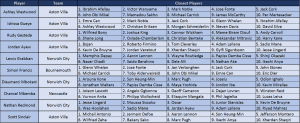 I didn’t watch Aston Villa much last season and have no opinion on Ashley Westwood to be honest. It’s good to see Nathan Redmond and Idrissa Gueye on there though, considering they have since moved to Everton and Southampton proving they were in fact capable of playing for better teams. The problem with this methodology though is that it assumes that the difference in player’s quality is lineal with league position. That is to say, the difference in quality between a player from the 16th team and one from the 20th team is assumed to be the same as the difference between a player from the champions and a player from the 5th team, when in truth there is no solid basis for this assumption. One way to deal with this is to apply an increasing concave function to league position so that the same differences in position lower down the table are weighted less than for higher placed teams. I tried out a few functions like log, square root, cubic root, etc., and the results vary marginally but the same core of names seems to pop out for most of them. As an example, the table below shows the results for this methodology applying the fourth root to league position:
I didn’t watch Aston Villa much last season and have no opinion on Ashley Westwood to be honest. It’s good to see Nathan Redmond and Idrissa Gueye on there though, considering they have since moved to Everton and Southampton proving they were in fact capable of playing for better teams. The problem with this methodology though is that it assumes that the difference in player’s quality is lineal with league position. That is to say, the difference in quality between a player from the 16th team and one from the 20th team is assumed to be the same as the difference between a player from the champions and a player from the 5th team, when in truth there is no solid basis for this assumption. One way to deal with this is to apply an increasing concave function to league position so that the same differences in position lower down the table are weighted less than for higher placed teams. I tried out a few functions like log, square root, cubic root, etc., and the results vary marginally but the same core of names seems to pop out for most of them. As an example, the table below shows the results for this methodology applying the fourth root to league position: 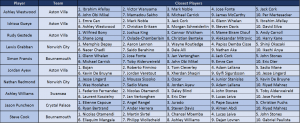 Some more satisfying names show up on there now (Ashley Williams who moved to Everton and Jason Puncheon who is pretty good), but it’s still unclear whether this methodology is properly representing the differences in quality required to play for different teams. Perhaps a better way to look at it is by points obtained rather than league position. Is the ratio of points a good representation of the difference in quality? The idea would be something like if a team obtains 90 points then its players must be 3 times as good as those of a team which obtains 30 points. The following table shows the top ten players such that the ratio between their teams’ points and the average points of the teams of their 10 closest players is greatest: NOTE: I had to exclude Aston Villa players here because they obtained such a small amount of points that right away the method assumed it was twice as hard to play for Norwich than for Villa (Aston Villa made 17 points and Norwich 34) and obviously all the Villa players dominated the rankings.
Some more satisfying names show up on there now (Ashley Williams who moved to Everton and Jason Puncheon who is pretty good), but it’s still unclear whether this methodology is properly representing the differences in quality required to play for different teams. Perhaps a better way to look at it is by points obtained rather than league position. Is the ratio of points a good representation of the difference in quality? The idea would be something like if a team obtains 90 points then its players must be 3 times as good as those of a team which obtains 30 points. The following table shows the top ten players such that the ratio between their teams’ points and the average points of the teams of their 10 closest players is greatest: NOTE: I had to exclude Aston Villa players here because they obtained such a small amount of points that right away the method assumed it was twice as hard to play for Norwich than for Villa (Aston Villa made 17 points and Norwich 34) and obviously all the Villa players dominated the rankings. 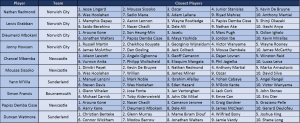 Nathan Redmond is on the list again which is good to see, as well as Moussa Sissoko who moved to Tottenham this season. M’Vila, Cisse and Watmore are other players on the list which I rate highly, but again, lets allow the reader to make his own judgements. To wrap this theme up, the final way of answering this question I used combines some of the best elements of the previous two ideas: for each player we compute the difference between the average squared points of the 10 closest players and his own team’s final points squared. The square is taken to compensate for the fact that the quality required to go from a 60-points team to an 80-points team is higher than the quality required to go from a 30-points team to a 50-points team. The table below shows the results:
Nathan Redmond is on the list again which is good to see, as well as Moussa Sissoko who moved to Tottenham this season. M’Vila, Cisse and Watmore are other players on the list which I rate highly, but again, lets allow the reader to make his own judgements. To wrap this theme up, the final way of answering this question I used combines some of the best elements of the previous two ideas: for each player we compute the difference between the average squared points of the 10 closest players and his own team’s final points squared. The square is taken to compensate for the fact that the quality required to go from a 60-points team to an 80-points team is higher than the quality required to go from a 30-points team to a 50-points team. The table below shows the results: 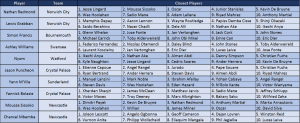 There are some good names on there. Redmond definitely seems to be a good catch by Southampton. Now, remember that this methodology isn’t meant to be a magic crystal ball. Some people who know I do this type of work constantly ask me: “So, who’s going to win the league? Who’s the next Messi?”. They fail to understand the subtlety of what there is to actually gain from data mining. Ashley Westwood might be great, but then again he might not. Nevertheless, some players which traditional scouting methods seem to like from last season which were recruited by larger teams are also liked by this method. It’s pretty remarkable that this methodology seems to be so rich when it is ignoring a lot of relevant information such as shots, goals, tackles, etc. It only sees what is visible in the passing network, which seems to be enough to make some decisions that very informed professional recruitment makes like picking up Gueye, Redmond, Sissoko, Ashley Williams, etc. That doesn't mean that it has all the answers. For example, it might like a centre back who is good at playing the ball out from the back but it has no way of knowing if he is also defensively sound. If complemented with more sources of information (such as direct traditional scouting), however, this type of work can be very useful for clubs. Finally and on a bit of a sourer note, I thought it might also be interesting to look at some of the “worst” opportunity players; that is to say players who are similar to players from much worse teams than their own. I had to exclude Leicester players because their players completely dominated the top ten in most lists I drew up; even Kante, Mahrez and Vardy. I’m not sure what to make of this, because even though they were the champions, their players aren’t particularly similar to the players from other top teams. Just so it doesn’t seem like I’m slipping something past you, here are the 10 closest players to Kante, Mahrez and Vardy:
There are some good names on there. Redmond definitely seems to be a good catch by Southampton. Now, remember that this methodology isn’t meant to be a magic crystal ball. Some people who know I do this type of work constantly ask me: “So, who’s going to win the league? Who’s the next Messi?”. They fail to understand the subtlety of what there is to actually gain from data mining. Ashley Westwood might be great, but then again he might not. Nevertheless, some players which traditional scouting methods seem to like from last season which were recruited by larger teams are also liked by this method. It’s pretty remarkable that this methodology seems to be so rich when it is ignoring a lot of relevant information such as shots, goals, tackles, etc. It only sees what is visible in the passing network, which seems to be enough to make some decisions that very informed professional recruitment makes like picking up Gueye, Redmond, Sissoko, Ashley Williams, etc. That doesn't mean that it has all the answers. For example, it might like a centre back who is good at playing the ball out from the back but it has no way of knowing if he is also defensively sound. If complemented with more sources of information (such as direct traditional scouting), however, this type of work can be very useful for clubs. Finally and on a bit of a sourer note, I thought it might also be interesting to look at some of the “worst” opportunity players; that is to say players who are similar to players from much worse teams than their own. I had to exclude Leicester players because their players completely dominated the top ten in most lists I drew up; even Kante, Mahrez and Vardy. I’m not sure what to make of this, because even though they were the champions, their players aren’t particularly similar to the players from other top teams. Just so it doesn’t seem like I’m slipping something past you, here are the 10 closest players to Kante, Mahrez and Vardy:  Now, excluding players from Leicester, here are the “worst” opportunities using the “squared points difference” metric outlined above:
Now, excluding players from Leicester, here are the “worst” opportunities using the “squared points difference” metric outlined above: 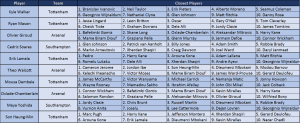 Make of it what you will, but keep in mind that everything has a context and even if I claim this method sees a lot, I also recognise it doesn't know everything. If you see a name in there you don't like, keep calm, take a deep breath, look through the closest players and have a think about what might be going on. _______________ Find me on twitter
Make of it what you will, but keep in mind that everything has a context and even if I claim this method sees a lot, I also recognise it doesn't know everything. If you see a name in there you don't like, keep calm, take a deep breath, look through the closest players and have a think about what might be going on. _______________ Find me on twitter